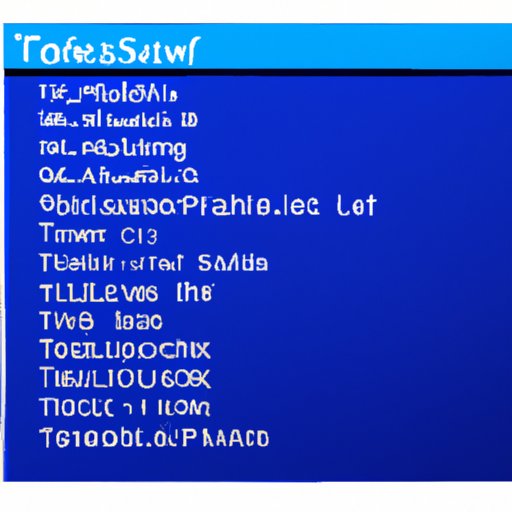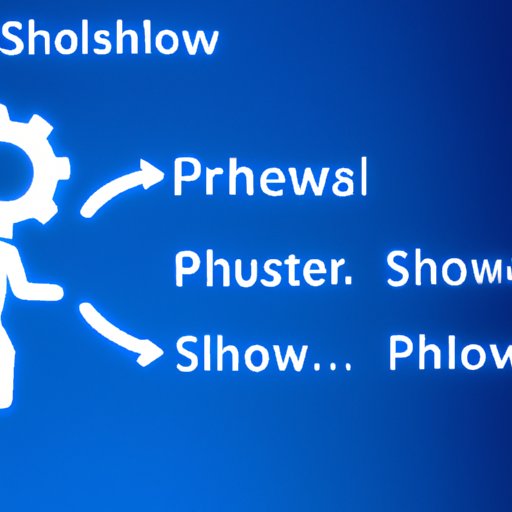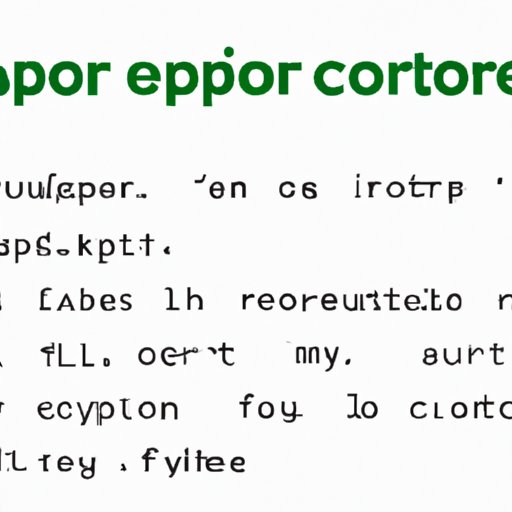Introduction
The Windows PowerShell scripting language is a powerful tool for automating tasks. Automation can help streamline IT processes, reduce manual labor, and save time and money. However, automation requires careful planning and implementation in order to be successful. In this article, we’ll explore the basics of automating PowerShell scripts, including the benefits and challenges of automation, as well as best practices for leveraging Windows Task Scheduler, functions, parameters, modules, cmdlets, workflows, profiles, and error handling.
Definition of PowerShell Script Automation
PowerShell script automation is the process of creating scripts that can run automatically on a schedule or when certain conditions are met. These scripts can be used to perform a variety of tasks, from simple system maintenance to complex data manipulation. Automating PowerShell scripts allows for greater efficiency, consistency, and accuracy in IT operations.
Overview of Benefits and Challenges of Automating PowerShell Scripts
Automating PowerShell scripts can provide many benefits, such as reducing manual labor, freeing up IT staff for other tasks, and improving accuracy. Additionally, automated scripts can be used to ensure compliance with industry standards and regulatory requirements. According to a study by Gartner, “automation can enable organizations to reduce operational costs by up to 80%.”
However, there are also some challenges associated with automating PowerShell scripts. For example, it can be difficult to test and debug an automated script, as it may not be easy to replicate the exact conditions under which the script will run. Additionally, automated scripts can have unintended consequences if they are not properly configured. As such, it is important to carefully plan and implement any automation projects.

Use Windows Task Scheduler to Automate PowerShell Scripts
Windows Task Scheduler is a built-in Windows utility that can be used to schedule tasks to run at specific times or when certain conditions are met. It can be used to automate PowerShell scripts by creating a task that runs the script at a specified time or interval. Here is an overview of how to use Windows Task Scheduler to automate PowerShell scripts.
Overview of Windows Task Scheduler
Windows Task Scheduler is a built-in Windows utility that enables users to create, modify, and delete tasks. Tasks can be scheduled to run at specific times or intervals, or they can be triggered by certain events. The Task Scheduler can also be used to manage multiple tasks simultaneously.
How to Set Up a Scheduled Task in Windows
To set up a scheduled task in Windows, open the Task Scheduler window and click “Create Basic Task.” Enter a name and description for the task, then select the frequency at which the task should run. Next, specify the time or event that should trigger the task. Finally, select the action that should be taken when the task is triggered (e.g., running a program).
Tips for Setting Up Tasks
When setting up tasks in Windows Task Scheduler, it’s important to ensure that the task has the correct permissions to run. Additionally, be sure to test the task before scheduling it to run. This will help ensure that the task runs as expected and does not cause any unexpected errors or problems.
Create a PowerShell Script Library for Reuse
Creating a PowerShell script library can help streamline automation efforts by allowing you to reuse scripts for multiple tasks. A PowerShell script library is a collection of scripts that can be used to automate various tasks. Here is an overview of how to create a PowerShell script library.
What is a PowerShell Script Library?
A PowerShell script library is a collection of scripts that can be used to automate various tasks. The scripts can be reused for different tasks, eliminating the need to write new scripts each time. Additionally, the scripts can be easily modified to meet specific needs.
How to Create a PowerShell Script Library
Creating a PowerShell script library is relatively straightforward. First, create a folder to store the scripts. Next, copy or create the scripts that you wish to include in the library. Finally, add the scripts to the library using the Add-PSSnapin command. This will allow the scripts to be used in the PowerShell environment.
Benefits of Creating a PowerShell Script Library
Creating a PowerShell script library can provide numerous benefits, including improved efficiency, reduced manual labor, and increased accuracy. Additionally, having a library of reusable scripts can help make automation projects easier to manage and maintain.

Utilize PowerShell Functions and Parameters
Using functions and parameters in PowerShell scripts can help simplify and streamline the automation process. Functions are reusable blocks of code that can be used to perform specific tasks, while parameters are used to provide input to the functions. Here is an overview of how to use PowerShell functions and parameters.
What are PowerShell Functions?
PowerShell functions are reusable blocks of code that can be used to perform specific tasks. Functions can be used to simplify complex automation tasks, making them easier to manage and maintain. Additionally, functions can be reused in other scripts, saving time and effort.
How to Use PowerShell Functions and Parameters
To use functions and parameters in PowerShell scripts, the function must first be defined. To do this, use the Function keyword followed by the name of the function. Then, define the parameters and their data types. Finally, enter the code to be executed when the function is called. Once the function has been defined, it can be used in other scripts.
Tips for Leveraging Functions and Parameters
When using functions and parameters in PowerShell scripts, it’s important to ensure that the parameters are valid and that the code within the function is correct. Additionally, be sure to document the functions and parameters to make it easier for others to understand and use the scripts.
Leverage PowerShell Modules and Cmdlets
PowerShell modules and cmdlets can be used to simplify and streamline the automation process. Modules are collections of related cmdlets that can be used to perform specific tasks, while cmdlets are small programs that can be used to perform individual tasks. Here is an overview of how to use PowerShell modules and cmdlets.
Overview of PowerShell Modules and Cmdlets
PowerShell modules are collections of related cmdlets that can be used to perform specific tasks. Cmdlets are small programs that can be used to perform individual tasks. For example, a cmdlet may be used to create a file, while a module may be used to create a folder structure.
How to Use PowerShell Modules and Cmdlets
To use PowerShell modules and cmdlets, first import the necessary modules into the PowerShell environment. Then, use the Get-Command cmdlet to view the available cmdlets. Finally, use the appropriate cmdlet to perform the desired task. For example, to create a file, use the New-Item cmdlet.
Tips for Working with PowerShell Modules and Cmdlets
When working with PowerShell modules and cmdlets, it’s important to ensure that the correct parameters are used. Additionally, be sure to read through the documentation for the cmdlets to ensure that they are used correctly. Finally, take advantage of the -Verbose parameter, which can provide additional information about the task being performed.

Employ PowerShell Workflows for Complex Automation
For more complex automation tasks, PowerShell workflows can be used to streamline the process. Workflows are sequences of commands that can be used to automate complex tasks. Here is an overview of how to use PowerShell workflows.
Overview of PowerShell Workflows
PowerShell workflows are sequences of commands that can be used to automate complex tasks. Workflows can be used to automate tasks that involve multiple steps or require the execution of multiple cmdlets. Additionally, workflows can be used to execute tasks in parallel, which can significantly improve performance.
How to Create a PowerShell Workflow
To create a PowerShell workflow, first create a workflow definition file. This file should contain the commands to be executed in the workflow. Then, use the Workflow keyword to define the workflow. Finally, call the workflow by using the Invoke-Workflow cmdlet.
Tips for Working with PowerShell Workflows
When working with PowerShell workflows, it’s important to ensure that the workflow definition file is structured correctly. Additionally, be sure to test the workflow before executing it. Finally, take advantage of the -Verbose parameter, which can provide additional information about the task being performed.
Incorporate PowerShell Profiles into Your Scripts
Using PowerShell profiles can help streamline the automation process by allowing you to configure settings that will be applied to all scripts. A PowerShell profile is a script that is executed when the PowerShell environment is initialized. Here is an overview of how to use PowerShell profiles.
What is a PowerShell Profile?
A PowerShell profile is a script that is executed when the PowerShell environment is initialized. The profile can be used to configure settings that will be applied to all scripts that are executed in the environment. For example, the profile can be used to set the default output format or to set aliases for cmdlets.
How to Create a PowerShell Profile
To create a PowerShell profile, first create a script file containing the desired configuration settings. Then, save the script file in the appropriate directory. Finally, use the Set-ExecutionPolicy cmdlet to set the execution policy for the profile.
Benefits of Using a PowerShell Profile
Using a PowerShell profile can provide numerous benefits, such as improved efficiency, reduced manual labor, and increased accuracy. Additionally, having a profile can help make automation projects easier to manage and maintain.

Implement Robust Error Handling in Your Scripts
Implementing robust error handling in PowerShell scripts can help ensure that the scripts run as expected. Error handling involves catching errors and taking appropriate action when they occur. Here is an overview of how to incorporate error handling into PowerShell scripts.
Overview of Error Handling
Error handling is the process of catching errors and taking appropriate action when they occur. In PowerShell scripts, errors can be caught using the Try/Catch block. This block allows the script to detect and respond to errors, ensuring that the script runs as expected.
How to Implement Error Handling in Your Scripts
To implement error handling in your scripts, first create a Try/Catch block. Then, define the actions to be taken when an error occurs. Finally, use the Write-Error cmdlet to log the errors to a log file. This will help ensure that errors are detected and handled appropriately.
Tips for Error Handling in PowerShell Scripts
When implementing error handling in PowerShell scripts, it’s important to ensure that the error messages are meaningful and that the appropriate action is taken when an error occurs. Additionally, be sure to log errors to a log file. This will help ensure that errors are detected and handled appropriately.
Conclusion
Automating PowerShell scripts can provide numerous benefits, including improved efficiency, reduced manual labor, and increased accuracy. However, it is important to carefully plan and implement any automation projects. This article provided an overview of how to automate PowerShell scripts, including the benefits and challenges of automation, as well as best practices for leveraging Windows Task Scheduler, functions, parameters, modules, cmdlets, workflows, profiles, and error handling.
(Note: Is this article not meeting your expectations? Do you have knowledge or insights to share? Unlock new opportunities and expand your reach by joining our authors team. Click Registration to join us and share your expertise with our readers.)
